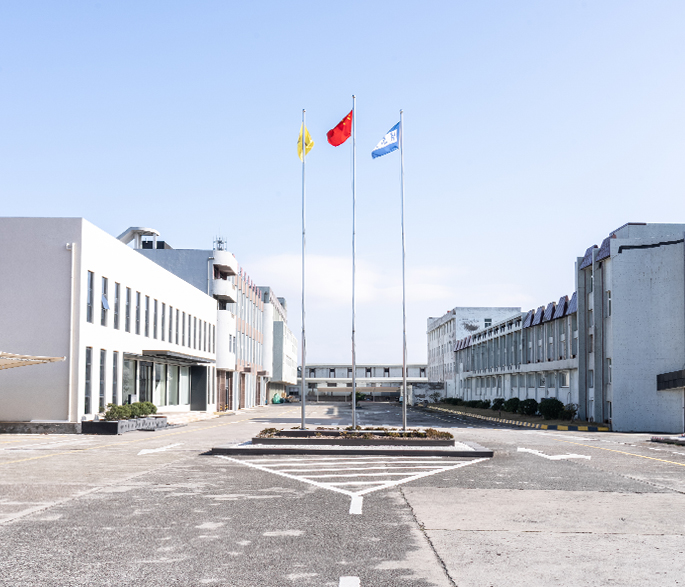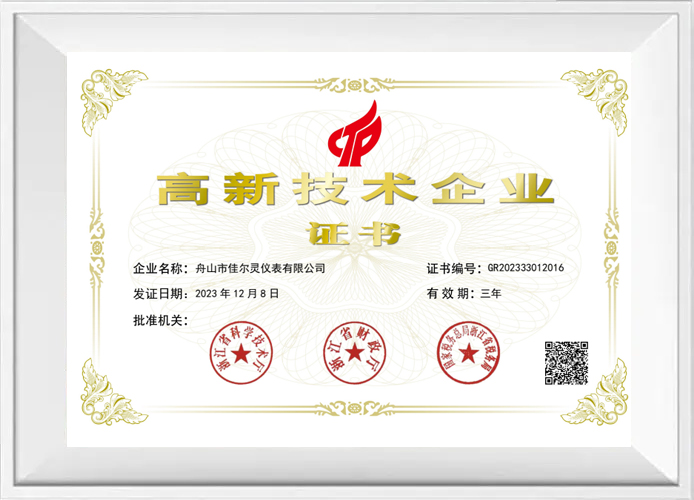Need help? Call us: +86-15105800333 / Whatsapp:+86-15105800333 / Email:[email protected]
- Home
- Product
- About
- Strength
- News
- Contact

Zhoushan Jiaerling Meter Co., Ltd. was established in 2004. It is China Water Treatment Pressure Gauge Manufacturers and Custom Water Treatment Pressure Gauge Suppliers, which is a high-tech enterprise integrating design, research and development, manufacturing, import and export trade.
The company is located in Zhoushan City, Zhejiang Province, covering an area of 15,000 square meters, equipped with a 100,000-level clean workshop, conventional production and assembly workshop, automated production workshop, new laboratory and comprehensive office building.
After more than 20 years of hard work and development, the company has a stable design and development, production team, and advanced production and testing equipment. The company specializes in the production of various types of pressure gauges with complete specifications, and the annual output of pressure gauges reaches 6 million. In order to further develop, the company not only seeks improvement in technology, but also pays more attention to product quality and after-sales service. The company's purpose is to "regard quality as life, survive by reputation, promote development by technology, and serve customers with high-quality brands". The products are sold all over the world and are well received by domestic and foreign customers.
In 2019, the company participated in the compilation of the standard T/CECS10012-2019 "Gas Heating Hot Water Boiler and Water Heater Water Circuit Components" of the China Engineering Construction Standardization Association.
Under the implementation of modern and digital enterprise management, the company has successfully introduced the advanced MES system in 2023, and the order process is fully visualized to track data, ensuring the continuity of production and improving production efficiency.
The company will continue to adhere to the principles of excellence, accuracy, reliability, continuous improvement, and meeting customer needs, hoping to share harmony and prosperity with friends across the country.








In the complex fluid measurements of the petroleum and chemical industries, the accuracy and stabili...
View MoreIn the rigorous environment of the petrochemical industry, the reliability of pressure measuring ins...
View MorePP diaphragm pressure gauges, with their polypropylene (PP) body and corrosion-resistant diaphragm m...
View MoreThe core function of a PP diaphragm pressure gauge, particularly one used in corrosive environments ...
View MoreFour Direct Impacts of an Inaccurate Brewing Pressure Gauge A brew pressure gauge displays the actua...
View MoreIn the water treatment industry, the pressure gauge is a key monitoring device, and the selection of its material is crucial, which directly affects the performance and service life of the equipment. JRL is well aware of this and is committed to developing high-performance water treatment pressure gauges, paying special attention to corrosion resistance, long-term stability, strength, toughness, sealing and safety to meet the needs of various harsh working conditions.
First of all, corrosion resistance and long-term stability are the core considerations for the selection of JRL pressure gauge materials. In the water treatment process, the corrosiveness of the medium places strict requirements on the material of the pressure gauge. To this end, JRL gives priority to high-performance corrosion-resistant materials such as stainless steel (such as 316 stainless steel) and titanium alloy, which can not only effectively resist the erosion of various corrosive media, but also ensure that the pressure gauge maintains high accuracy and stability in long-term operation. In addition, JRL has conducted rigorous testing on the selected materials to ensure that their physical and chemical properties remain stable under different temperature, pressure and environmental conditions, thereby significantly extending the service life of the pressure gauge.
In the water treatment environment, the pressure gauge may be subjected to external shock and vibration, so its material must have excellent mechanical properties. To this end, JRL uses high-strength, high-toughness alloy steel and special alloy materials to ensure that the pressure gauge can withstand greater pressure and impact in complex environments, maintain structural integrity and measurement accuracy. Such material selection not only improves the durability of the product, but also provides users with more reliable monitoring data.
Sealing is the basis for ensuring the normal operation of the pressure gauge and the accuracy of the data. In this regard, JRL pays attention to the quality and performance of sealing materials, and uses highly elastic seals and corrosion-resistant sealing materials to ensure that good sealing effects can be maintained under various working conditions. In addition, JRL also strictly follows international safety standards and selects standard materials and manufacturing processes to ensure that the pressure gauge will not leak or explode under extreme conditions such as high pressure and high temperature, and ensure the safety of users and the stable operation of the equipment.
In the process of calibrating the pressure gauge, JRL's professional technical team will take a series of systematic preparation and execution measures to ensure the high accuracy and reliability of the calibration results. First, the technicians will conduct a comprehensive appearance and structural inspection of the pressure gauge to ensure that there is no damage or leakage in its physical state, and confirm that the model, range and accuracy level of the pressure gauge are consistent with the actual use requirements. In addition, the team will also prepare standard calibration equipment that has been strictly calibrated and certified, such as piston pressure gauges and pressure sensor calibration devices, to ensure the accuracy of data during the calibration process.
The control of the calibration environment is an important factor affecting the calibration results. JRL has an advanced calibration laboratory equipped with a temperature and humidity control system to ensure that the temperature of the experimental environment is stable at 20±5℃ and the relative humidity does not exceed 85%. Such an environmental setting can effectively reduce the interference of external factors on the performance of the pressure gauge, thereby improving the reliability of the calibration results. At the same time, the cleanliness of the laboratory is also strictly managed to prevent impurities such as dust and oil from negatively affecting the measurement of the pressure gauge.
In the specific calibration steps, the first thing to do is zero point calibration. The technician will put the pressure gauge in a pressure-free state, adjust the pointer or digital display to zero, and ensure that the reading at the starting point of the measurement is accurate. Next, enter the range calibration stage. The technician will use standard calibration equipment to select multiple calibration points within the range of the pressure gauge, such as 25%, 50%, 75% and 100% range points, gradually apply pressure and record the reading of the pressure gauge, and then compare and analyze it with the standard value.
During this process, if a deviation is found between the pressure gauge reading and the standard value, the technician will adjust the error of the pressure gauge according to the specific situation. For spring tube pressure gauges, it may be necessary to adjust the pointer position or the indication adjustment screw; for electronic pressure gauges, it may be achieved through software calibration or adjustment of sensor parameters. After completing the range calibration, the technician will also verify the repeatability and return error to ensure that the pressure gauge reading changes meet the preset accuracy requirements after multiple pressurization and decompression at the same calibration point.
The last step of the calibration process is recording and reporting. The technician will record the data of the entire calibration process in detail, including calibration points, readings, deviations and adjustments, and prepare a formal calibration report. This report is not only a formal document of the calibration results, but also an important reference for customers' subsequent use.